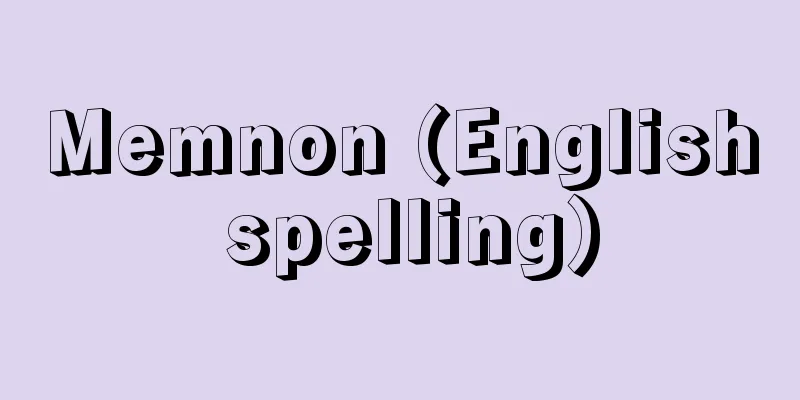Mystery novel - Suiri Shosetsu

|
Currently, the terms detective story and mystery are used as general terms for literary works in this genre, but here they are treated as synonyms. Edogawa Ranpo's definition of detective novels is representative: "literature that focuses on the fascinating process of how complex secrets, mainly related to crimes, are logically and gradually unraveled." Ranpo lists three conditions for an interesting novel: (1) the incomprehensibility of the beginning, (2) the suspense of the process, and (3) the unexpectedness of the ending. In other words, the detective novels that Ranpo defines as detective novels are so-called full-scale detective novels that are based on tricks. However, detective novels today include a wide variety of mysteries, such as spy thrillers and hard-boiled novels, in addition to full-scale detective novels, and it is virtually impossible to give a concise definition of detective novels in the broad sense. [Jun Atsugi] Types of detective novelsThey can be roughly divided into the following eight categories: [1] Full-scale detective novels are works that rely on tricks and follow the basic format of detective novels, which is the presentation of a mystery, deduction, and a rational solution. [2] Inverted detective novels are works that are the reverse of a full-fledged novel, in which the culprit and his crime are clearly stated at the beginning, and then a detective appears to deduce the culprit. Therefore, the reader's interest is not in the whodunit (who is the culprit?), but in the process of deduction, that is, how the detective uncovers the flaws in the perfect crime. [3] Hard-boiled: This style of novel emerged in the United States at the end of the roaring 1920s, symbolized by Prohibition and Al Capone. It is characterized by the strong personalities of its heroic private detectives, a unique writing style that is concise and makes extensive use of slang, and the lonely world of unsentimental tough guys. It does not place emphasis on tricks, but rather on realistic character portrayals as the foundation of its works. [4] Spy thrillers The genre began with thrillers based on the international conspiracies between Britain and Germany before World War I, and Britain has dominated this field. The rivalry between these two great powers continued in the form of a war of wits between the United States (CIA) and the Soviet Union (KGB). Instead of criminals and detectives, the battle of wits here is between spies and counter-spies. [5] Suspense Novel: A type of detective novel that focuses on the psychological thrills and suspense of the characters in parallel with solving the mystery of the incident. It emerged in response to the lack of original tricks. [6] Courtroom Novels: These novels are set in a courtroom, with the defense lawyers trying to prove the defendant’s innocence and the prosecution engaging in lively debates. One of the highlights of the novel is the defense lawyers’ skillful cross-examination. [7] Police novels: While traditional mystery novels feature famous detectives or investigators as their protagonists, police novels depict the investigative methods and teamwork of the police as an organization. This is a type of realism that emerged after World War II. [8] Adventure Mystery This is a series of works that do not fall into any of the above genres, but cannot be ignored in terms of the number of authors and works. It adds action, a taste of adventure, or a sense of strangeness to the mystery of the incident, and has continued from the Arsène Lupin works by Maurice Leblanc to the works of Alistair MacLean and Clive Cussler (1931-2020) today. It is literally an adventure novel with detective elements added. [Jun Atsugi] Foreign detective novelsToday, it is generally accepted that detective novels began with The Murders in the Rue Morgue by E. A. Poe, published in 1841. There were many works before that that simply had crime or mystery as their theme. In particular, 18th century English Gothic romance can be considered to be the origin of the detective novel in a broad sense. However, Poe was the first to introduce the logic of deduction and the rationality of solution into modern novels, and to originate this form. Moreover, Poe's pattern of a civilian (Auguste Dupin) with genius deductive abilities solving criminal cases before mediocre police is still followed by many detective writers today, a century and a half later. Conan Doyle took the lead of Wilkie Collins (1824-1889) in perfecting the detective novel that Poe had created in America and perfected it in England. After this, detective novels spread around the world, led by both England and America. The serialization of Sherlock Holmes, who became synonymous with the great detective, began in The Strand Magazine in 1891, 50 years after Poe's The Murders in the Rue Morgue. The commercial success of Sherlock Holmes quickly gave rise to many imitators and rivals. Raffles by Ernest William Hornung (1866-1921), Dr. Thorndike by Freeman, the Old Man on the Corner by Orczy, and Father Brown by Chesterton were born in the late 19th century and early 20th century. Freeman created a new style called the inverted detective novel, and Chesterton gave detective novels a high literary quality by making full use of high-brow paradoxes. In France, Emile Gaborio (1832-1873) published a long detective novel based on Lecoq before Conan Doyle. In the 20th century, two authors, Gaston Leroux and Maurice Leblanc, appeared, and the latter's Arsène Lupin became as popular as Sherlock Holmes. After this period of growth, the full-scale detective novel reached its "Golden Age" in the 1920s and 1930s. The main British authors and their works of that time include Crofts's The Barrel (1920), A. A. Milne's The Mystery of the Red House (1922), Philpotts's The Redheads (1922) and A Voice in the Dark (1925), A. E. W. Mason's The House of Arrows (1924), and Christie's The Murder of Roger Ackroyd (1926). Crofts, in particular, showed ingenuity in the alibi trick, while Christie created the famous detective Hercule Poirot, earning her the accolade of being known as the "Queen of Mysteries." Dickson Carr vigorously pursued locked room and footprint tricks, while Francie Iles (1893-1971, also known as Antony Berkeley) and Richard Hull (1896-1973) developed the inverted mystery novel and dissected the psychology of criminals. After Poe, the only writer of American mystery novels was Melvill Davisson Post (1869-1930), a short story writer who wrote stories such as The Uncle Abner Stories. But in 1926, Van Dine appeared like a comet on the scene. His style of writing, which develops a well-organized logic based on a tightly-conceived plan, combined with his pedantic style of writing, created a great sensation. Incidentally, Van Dine was the one who had the greatest influence on Japanese mystery writers before the Second World War, and with his appearance, the mainstream of mystery novels shifted from England to America. Ellery Queen followed Van Dine, and he perfected the "challenge to the reader" style by taking the mystery solving of serious novels even further. Ellery Queen and Dickson Carr were the last masters to decorate the golden age of serious mystery novels, but after the 1930s, serious mystery novels gradually went into decline due to a lack of original tricks. In 1929, the same year that Ellery Queen appeared, Dashiell Hammett's Blood Harvest introduced the uniquely American hard-boiled school of mysteries. The dry, idiosyncratic style of writing, which emphasizes realistic characterization of the people involved rather than solving mysteries, was inherited by Raymond Chandler in the 1940s and was highly acclaimed as a literary work. Representative writers from the 1970s to the 1990s include Robert B. Parker (1932-2010) and Lawrence Block (1938- ). E. S. Gardner is a writer of this genre who wrote action-oriented courtroom novels, and currently active courtroom writers include John Grisham (1955- ) and Scott Turow (1949- ). The decline of serious detective novels and the rise of the hard-boiled school created a multi-polar phenomenon in the world of detective novels. Simenon, who pursued the unique psychology of criminals without being concerned with tricks, rose to prominence in France, and in the United States, W. Irish (also known as C. Woolrich), a master of suspenseful novels filled with tension, appeared. In the second half of the 1930s, Peter Cheyney (1896-1951) and Hadley Chase (1906-1985) introduced the hard-boiled style to Britain, and in France, gangster novels known as romain noir, which made extensive use of slang, were born. The spy thriller, a genre of detective novel, developed in the U.K. Starting with The Mystery of the Reef (1903) by Erskine Childers (1870-1922), which was based on the theme of the Anglo-German conflict in the early 20th century, and continuing through John Buchan's The Thirty-Nine Steps and Somerset Maugham's Ashenden (1928), spy novels escaped the realm of vulgar adventure novels. In the late 1930s, against the backdrop of the tense international situation on the eve of World War II, the first first-class professional writer, Eric Ambler, was born. At the same time, Graham Greene also contributed to the maturation of the genre with "entertainment" such as The Secret Agent (1939). After the end of World War II, the American military invaded various parts of the world, bringing with them mystery novels and science fiction. At the same time, the publishing revolution of mass sales of paperbacks played a major role in the spread of mystery novels as entertainment literature in various countries. In the United States, Ross MacDonald, the orthodox hard-boiled, Mickey Spillane, and William Peter McGivern (1918-1982), who could be called a socially conscious hard-boiled, appeared one after another. In the 1950s, police novels were popular, and Thomas Walsh (1908-1984), Ben Benson (1915-1959), Ed McBain, and Hillary Waugh (1920-2008) emerged, and in the 1960s, the works of the Swedish husband-wife writer duo Per Bahl and Maj Sjöbard became popular. In the field of short mystery stories, Fredric Brown, Henry Slesar (1927-2002), and Roald Dahl (1916-1990) all wrote witty, light-hearted works, but these types of short stories, or short stories with a "strange flavor," were rarely seen before the war. Due to the lack of original tricks, mystery writers began to use variations and combinations of existing tricks, and they also placed more importance on motives than on tricks, focusing on suspense and twists in the plot. Writers of this trend in France include Boileau Narcejac, Catherine Arley (1924- ), and Sébastien Japrisot (1931-2003), while in the UK Joyce Porter (1924-1990) was known for flavoring her works with humor. Two other popular female writers have also emerged: Phyllis Dorothy James (1920-2014), who wrote serious, serious novels, and Ruth Rendell (1930-2015), who wrote psychological thrillers in parallel with her serious works. Peter Lovesey (1936-), who specializes in period mysteries set in the Victorian era, and Dick Francis, author of the "Horse Races" series, have also been actively publishing works. Spy novels are a direct reflection of the Cold War and the secret struggle between the East and the West. In the 1950s, Ian Fleming wrote the "007" series and became a world-famous author. In the 1960s, Len Deighton and John le Carré wrote realistic spy novels, and in the 1970s, Frederick Forsyth emerged and led the field. A. J. Quinnell, Brian Freemantle (1936-), and Jack Higgins (1929-) also demonstrated their talents as storytellers in novels of international intrigue, and Ken Follett (1949-) was well-received for his innovative spy stories. In the field of spy thrillers, perhaps due to the strength of tradition, it can still be said that Britain has an edge over the United States. In the United States, Tom Clancy (1947-2013), who made his debut with The Hunt for Red October (1984), pioneered the genre of high-tech military thrillers. A noticeable trend in detective novels from the 1970s to the 1990s was the increase in psychopathic criminals, replacing the traditional cunning and rational criminals. Psychological thrillers reflect the fact that modern society exists side by side with various forms of insanity. A century and a half has passed since its birth, and mystery novels have established an unshakable position in the realm of entertainment literature. They will continue to develop in a variety of ways against the backdrop of turbulent world situations and social life. [Jun Atsugi] Japanese detective novelsRiding the wave of modernization, Aibana Koson translated and introduced Poe's The Murder at Lou Morgue in 1887 (Meiji 20), 46 years after the publication of the original work. In the 1880s, translated (adapted) mysteries were in vogue, and Kuroiwa Ruiko serialized full-length mystery novels by Fortune du Boisgobey (1824-1891), Gaboriau, W.W. Collins, and others in newspapers, winning acclaim from readers, but this did not create an opportunity to produce full-scale original mystery novels. In the Taisho era, influenced by Poe and Doyle, Tanizaki Junichiro and Sato Haruo wrote several excellent short stories using mystery novel motifs, and Okamoto Kidō also wrote the topknot mystery novel Hanshichi Torimonochō. However, all of these works were different from the detective novels that develop precise logic in modern society. The magazine "Shin Seinen" launched in 1920 (Taisho 9) began publishing translated detective novels as reading material, and this became the catalyst for Edogawa Rampo's debut work "Two-Sen Copper Coin" in 1923, which marked the birth of full-fledged detective novels produced in Japan. Rampo continued to publish excellent short and medium-length stories through the early Showa period, establishing the genre of original detective novels, and his success inspired other writers, including Yokomizo Seishi, Tsunoda Kikuo, Koga Saburo, Oshita Udaru, Kozakai Fuboku, and Yumeno Kyusaku. However, most of their works were short stories, and only a few focused on deduction or analysis of mysteries. Most of their works were fantasy of the bizarre or crime novels that made use of detective interests. In the 1930s, masterpieces from the so-called "Golden Age" of British and American novelists such as Philpotts, Crofts, Queen, and E.C. Bentley were introduced, and two full-length novels, "The Murderer" (1931) by Hamao Shiro and "The Black Death Mansion Murder Case" (1934) by Oguri Mushiro, were written under the influence of Van Dine in particular. Kigi Takataro, who advocated the art of detective fiction, also published "The Fool of Life" (1936), and original mystery novels finally entered the era of full-length novels. However, this growth trend was stifled by the outbreak of World War II, and mystery writers were practically banned from writing. After the Second World War, Yokomizo Seishi, Sakaguchi Ango, and Takagi Akimitsu published powerful works that completely changed the prewar standards, followed by Shimada Kazuo and Ayukawa Tetsuya, and also the emergence of unique writers such as Yamada Futaro and Kayama Shigeru. Around 1955, specialized publishers began to regularly introduce excellent works of mystery from overseas, which spurred the rise of mystery novels. Then, in 1957, Matsumoto Seicho published "Dot and Line," which brought about a revolutionary change in domestic mystery novels since the appearance of Rampo. This was the birth of a socially conscious mystery novel based on realism that rejected the emphasis on tricks, and it further enhanced the maturity of Japanese mystery novels as literature. The new orthodox writers Takigawa Kyo, Tsuchiya Takao, Sasazawa Saho, Sano Hiroshi, Morimura Seiichi, and spy novelists Nakazono Eisuke, Yuki Shoji, and Miyoshi Toru were all active in this period, and the lineage of female writers beginning with Niki Etsuko and Togawa Masako, and continuing through Natsuki Shizuko, Koike Mariko, Miyabe Miyuki, Takamura Kaoru, and Kano Tomoko (1966-), was also a phenomenon unique to the postwar period. In line with overseas trends, creative mystery novels have become more diverse, and the themes of novels have expanded from the traditional personal greed for money and grudges to industrial espionage, pollution issues, corruption, and international crime, broadening the social scope of their scope. Among these, Ooka Shohei's "The Incident" (1977) was highly praised as a full-scale court case novel, which had been almost absent until then. Also, as part of this diversification, hard-boiled-oriented writers such as Ikushima Jiro, Kitakata Kenzo, and Osawa Arimasa appeared. Two trends are noteworthy from the 1980s to the 1990s. One is the emergence of new orthodox writers who aimed to revive orthodox (mystery-solving) detective novels, which had been in decline for a time due to the lack of original tricks and the popularity of socially conscious mysteries. These writers include Shimada Soji, Yamaguchi Masaya (1954-), Kyogoku Natsuhiko, Kasai Kiyoshi, and Ayatsuji Yukito (1960-). The other is the recent emergence of adventure fiction, which had existed for a long time. These works are quite different in character from the adventure mysteries mentioned in the above section "Types of Mystery Novels" [8], and are often large-scale in concept and set internationally. If we limit our consideration to the authors who have received the Mystery Writers of Japan Award since 1989, there have been four winners in the past ten years: Funado Yoichi, Sasaki Jo, Fujita Yoshinaga, and Mabo Yuichi. In addition to detective novels that focus on solving mysteries and suspense, the popularity of adventure novels with themes of thrills and (international) intrigue is a sign that the term mystery is becoming more and more diverse. [Jun Atsugi] "Detective Fiction: Growth and the Age - Murder as Entertainment" by Howard Haycraft, translated by Hayashi Shunichiro (1961, Togensha)" ▽ "Modern Mystery Fiction Series, Volume 2, Mystery Handbook" edited by Nakajima Kotaro (1980, Kodansha)" ▽ "History of Japanese Mystery Fiction, by Nakajima Kotaro, 3 volumes (1993, 1994, 1996, Tokyo Sogensha)" [References] | | | | |Ooka | | | | | | | | | | | | | | | | | | | | | | | | |Source: Shogakukan Encyclopedia Nipponica About Encyclopedia Nipponica Information | Legend |
|
このジャンルの文学作品の総称としては、推理小説detective storyとミステリーmysteryということばが現在使われているが、ここでは同義語として扱う。推理小説の定義としては、江戸川乱歩の「主として犯罪に関する難解な秘密が、論理的に、徐々に解かれていく経路のおもしろさを主眼とする文学」というのが代表的である。乱歩は、おもしろさの条件として、(1)発端の不可解性、(2)過程のサスペンス、(3)結末の意外性、の三つをあげている。すなわち乱歩の定義の対象とされる推理小説とは、トリック本位のいわゆる本格推理小説のことである。しかし現在の推理小説は、本格推理小説以外にも、スパイ・スリラーやハードボイルドなど多種多様なミステリーを包含しており、広義の推理小説を簡潔に定義することは事実上不可能といえよう。 [厚木 淳] 推理小説の種類おおよそ次の八つに分類できる。 〔1〕本格推理小説 トリック本位の作品で、謎(なぞ)の提出、推理、合理的解決という、推理小説本来の基本的形式を踏んだもの。 〔2〕倒叙推理小説 本格物を裏返ししたもので、犯人とその犯行が冒頭で明示され、次に探偵が登場して犯人を推理するという構成の作品。したがって読者の興味は「フーダニット」(Who-dunit 犯人はだれか?)ではなく、探偵がいかにして完全犯罪の欠陥を暴露するかという推理の過程に置かれる。 〔3〕ハードボイルド 禁酒法とアル・カポネが象徴する狂乱の1920年代の末期、アメリカに登場した流派で、ヒーローである私立探偵の強烈な個性、簡潔でスラング(俗語)を多用した独得の文体、非感傷的なタフ・ガイの孤独な世界などが特徴で、トリックは重視せず、リアルな人物描写が作品の根幹となっている。 〔4〕スパイ・スリラー 第一次世界大戦前の英独間の国際謀略に取材した型のスリラーに始まり、とくにこの分野はイギリスの独壇場である。この二大国間の抗争という図式は、その後もアメリカ(CIA)とソ連(KGB)の謀略戦という形で引き継がれた。犯人と探偵にかわって、ここで知恵比べをするのは、スパイとカウンター・スパイである。 〔5〕サスペンス小説 事件の謎解きと並行して、登場人物の心理的なスリルやサスペンスの描写に重点を置いたもので、独創的なトリックの枯渇に対応して出現した推理小説。 〔6〕法廷小説 法廷が舞台となり、被告の無実を証明する弁護人と検察側が丁々発止(ちょうちょうはっし)の論戦を交え、とくに弁護人の巧みな反対尋問が見どころの一つとなる。 〔7〕警察小説 従来の推理小説が名探偵や名捜査官を主人公とするのに対し、組織としての警察の捜査方法とそのチームワークを描くもので、第二次世界大戦後に台頭したリアリズムの一種。 〔8〕冒険ミステリー 以上のどの流派にもあてはまらないが、作家と作品の数のうえから無視できない一連の作品。事件の謎にアクションと冒険味、ないしは怪奇性を加えたもので、古くはモーリス・ルブランのアルセーヌ・ルパンものから現在のアリステア・マクリーンやクライブ・カッスラーClive Cussler(1931―2020)の作品まで連綿と続いている。文字どおり、冒険小説に推理小説的要素を加味したものである。 [厚木 淳] 海外の推理小説推理小説は1841年に発表されたE・A・ポーの『モルグ街の殺人』に始まる、というのが今日の定説である。単に犯罪や推理を主題にした作品はそれ以前にも多くみられる。とくに18世紀イギリスのゴシック・ロマンが広い意味で母胎とも考えられる。しかし推理の論理性と解決の合理性を近代小説に導入し、この形式を創始したのはポーが最初である。しかも天才的推理能力の持ち主である民間人(オーギュスト・デュパン)が凡庸な警察に先んじて犯罪事件を解決するというポーのパターンは、1世紀半たった今日でもいまだに多くの推理作家たちによって踏襲されている。 ポーがアメリカで創始した推理小説を、ウィルキー・コリンズWilkie Collins(1824―1889)の後を受けてイギリスで完成させたのがコナン・ドイルである。これ以後、推理小説は英米両国が主導する形で世界に普及していく。名探偵の代名詞になったシャーロック・ホームズものの連載が『ストランド・マガジン』で始まったのはポーの『モルグ街の殺人』から50年後の1891年で、シャーロック・ホームズの商業的成功はたちまち多くの模倣者やライバルを生んだ。ホーナングErnest William Hornung(1866―1921)のラッフルズ、フリーマンのソーンダイク博士、オルツィの隅の老人、チェスタートンのブラウン神父らが19世紀末から20世紀初頭に生まれた。フリーマンは倒叙推理小説という新形式を創始し、チェスタートンは高踏的逆説を駆使して推理小説に高い文学性を与えた。フランスでは、コナン・ドイルよりも先にエミール・ガボリオEmile Gaborio(1832―1873)がルコック探偵ものの長編を発表している。20世紀に入ると、ガストン・ルルーとモーリス・ルブランという2人の作家が現れ、後者が生んだアルセーヌ・ルパンはシャーロック・ホームズと並ぶポピュラーな存在となった。 本格推理小説はこうした成長期を経て、1920年代から1930年代にかけて「黄金時代」を築くことになる。当時のイギリスの主要作家と作品を列挙すると、クロフツの『樽(たる)』(1920)、A・A・ミルンの『赤い館(やかた)の秘密』(1922)、フィルポッツの『赤毛のレドメイン家』(1922)と『闇(やみ)からの声』(1925)、A・E・W・メースンの『矢の家』(1924)、クリスティの『アクロイド殺人事件』(1926)などがある。なかでもクロフツはアリバイ・トリックに創意をみせ、クリスティは名探偵エルキュール・ポアロを創造して「ミステリーの女王」とうたわれた。ディクスン・カーは密室や足跡トリックを精力的に追究し、フランシス・アイルズFrancie Iles(1893―1971。別名アントニー・バークリー)とリチャード・ハルRichard Hull(1896―1973)は倒叙推理小説を発展させて犯罪者の心理を解剖した。 ポー以降、アンクル・アブナーものなどの短編作家M・D・ポーストMelvill Davisson Post(1869―1930)を数えるのみのアメリカ推理小説界に、1926年、彗星(すいせい)のようにバン・ダインが登場した。緊密な構想のもと整然とした論理を展開するその作風は、ペダンティックな文体と相まって大きな反響を巻き起こした。ちなみに、第二次世界大戦前の日本の推理作家にもっとも影響を与えたのはこのバン・ダインで、彼の登場とともに推理小説の主流はイギリスからアメリカへと移行した。バン・ダインの後を受けて登場したのがエラリー・クイーンで、本格ものの謎解きをさらに展開して「読者への挑戦」形式を完成させた。エラリー・クイーンとディクスン・カーは本格派の黄金時代を飾る最後の巨匠で、1930年代を境にして、独創的トリックの枯渇から本格派はしだいに低迷の方向をたどった。 エラリー・クイーン登場と同年の1929年、ダシール・ハメットの『血の収穫』によってハードボイルド派というアメリカ独自のミステリーが登場した。謎解きよりも事件関係者のリアルな性格描写を重視し、乾燥した特異な文体による行動主義の作風は、1940年代に入ってレイモンド・チャンドラーによって受け継がれ、文学的にも高く評価された。1970年代から1990年代へかけての代表的作家にロバート・B・パーカー(1932―2010)とローレンス・ブロックLawrence Block(1938― )がいる。この系統の作家で、行動派の法廷小説を手がけたのがE・S・ガードナーであるが、現在活躍している法廷ものの書き手としては、ジョン・グリシャムJohn Grisham(1955― )とスコット・トゥローScott Turow(1949― )がいる。 本格派の低迷、ハードボイルド派の台頭によって推理小説の世界にも多極化現象が生まれた。トリックにこだわらず特異な犯罪心理を追究するシムノンがフランスで頭角を現し、アメリカでも緊迫感に満ちたサスペンス小説の名手W・アイリッシュ(別名C・ウールリッチ)が登場し、1930年代の後半にはピーター・チェイニーPeter Cheyney(1896―1951)とハドリー・チェイスHadley Chase(1906―1985)がハードボイルド派のスタイルをイギリスに導入し、フランスでも隠語を多用したロマン・ノアールというギャング小説が生まれた。 推理小説の一分野であるスパイ・スリラーはイギリスで発達した。20世紀初頭の英独抗争を主題にしたアースキン・チルダーErskine Childers(1870―1922)の『砂洲(さす)の謎』(1903)に始まり、ジョン・バカンの『三十九階段』からサマセット・モームの『アシェンデン』(1928)に至る系譜によって俗悪な冒険小説の域を脱したスパイ小説は、1930年代の後半、第二次世界大戦前夜の緊迫した国際情勢を背景に、初めて第一級の専門作家エリック・アンブラーを生み、これと時を同じくしてグレアム・グリーンも『密使』(1939)などの「エンターテイメント」によって、このジャンルの成熟に貢献した。 第二次世界大戦の終結とともに世界各地に進駐したアメリカ軍は推理小説とSFを持ち込んだが、同時にペーパーバックによる大量販売という出版革命が、各国において娯楽文学としての推理小説の普及に大きな役割を果たした。アメリカでは正統ハードボイルドの担い手としてロス・マクドナルド、通俗ハードボイルドのミッキー・スピレーン、社会派ハードボイルドともいうべきW・P・マッギバーンWilliam Peter McGivern(1918―1982)が相次いで登場した。1950年代で注目されるのは警察小説の流行で、トマス・ウォルシュThomas Walsh(1908―1984)、ベン・ベンスンBen Benson(1915―1959)、エド・マクベイン、ヒラリー・ウォーHillary Waugh(1920―2008)らが輩出し、1960年代に入ると、スウェーデンの夫婦作家ペール・バールー‐マイ・シューバールの作品が人気を博した。短編ミステリーの分野でも、フレドリック・ブラウン、ヘンリー・スレッサーHenry Slesar(1927―2002)、ロアルド・ダールRoald Dahl(1916―1990)などが洒脱(しゃだつ)軽妙な作品を書いたが、この種のショート・ショートや「奇妙な味」の短編は、戦前にはほとんどみられなかったものである。 独創的トリックの枯渇によって推理作家たちは既成トリックのバリエーションやコンビネーションを使うようになり、またトリックよりも動機が重視され、サスペンスとひねりのきいたプロットが中心になった。この傾向の作家としてフランスではボアロー・ナルスジャック、カトリーヌ・アルレーCatherine Arley(1924― )、セバスチャン・ジャプリゾSébastien Japrisot(1931―2003)らが注目を浴び、イギリスではジョイス・ポーターJoyce Porter(1924―1990)が作品全体をユーモアで味つけして特色を発揮した。さらに重厚な本格派のP・D・ジェイムズPhyllis Dorothy James(1920―2014)、本格物と平行してサイコ・スリラーを書くルース・レンデルRuth Rendell(1930―2015)と、2人の人気女性作家が登場し、またビクトリア朝を舞台にした時代ミステリーを得意とするピーター・ラブゼイPeter Lovesey(1936― )、「競馬シリーズ」のディック・フランシスも精力的に作品を発表した。 東西両陣営の冷戦と暗闘を直接反映したのがスパイ小説である。イギリスでは1950年代にイアン・フレミングが「007シリーズ」を書いて一躍世界的流行作家になり、1960年代にはレン・デイトンとジョン・ル・カレの2人がリアリズム・スパイ小説を、1970年代にはフレデリック・フォーサイスが登場してこの分野をリードした。A・J・クィネル、B・フリーマントルBrian Freemantle(1936― )、ジャック・ヒギンズJack Higgins(1929― )も国際的な謀略小説にストーリー・テラーの本領を発揮し、ケン・フォレットKen Follett(1949― )も新趣向のスパイ物で好評を博した。スパイ・スリラーの分野では伝統の強味であろうか、依然としてアメリカに比べてイギリスに一日の長があるといえる。またアメリカでは『レッド・オクトーバーを追え』(1984)で登場したトム・クランシーTom Clancy(1947―2013)がハイテク軍事スリラーという分野を開拓した。 1970年代から1990年代へかけての推理小説の傾向で目につくのは、従来の奸知(かんち)にたけた理性的な犯罪者のかわりに、サイコティックな犯人の増加である。現代社会が、実はさまざまな狂気と隣り合わせに成立していることの反映がサイコ・スリラーである。 誕生以来1世紀半を経過して、娯楽文学の領域で不動の地位を確立した推理小説は、今後も激動する世界情勢や社会生活を背景に多様な展開を続けていくであろう。 [厚木 淳] 日本の推理小説文明開化の波にのってポーの『ルー・モルグの人殺し』が饗庭篁村(あえばこうそん)によって翻訳紹介されたのが1887年(明治20)、原作の発表から46年後である。明治20年代は翻訳(翻案)ミステリーが流行した時期で、黒岩涙香(るいこう)がボアゴベイFortune du Boisgobey(1824―1891)、ガボリオ、W・W・コリンズなどの長編推理小説を新聞に連載、読者の喝采(かっさい)を博したが、本格的創作推理小説を生むほどの機縁とはならなかった。大正時代に入ると、ポー、ドイルの影響を受けて谷崎潤一郎と佐藤春夫が推理小説的モチーフを取り上げて好短編をいくつか書き、岡本綺堂(きどう)も髷物(まげもの)推理小説『半七捕物帳』を書いた。しかし、いずれも近代社会のなかで緻密(ちみつ)な論理性を展開する推理小説とは異質のものであった。1920年(大正9)に創刊された雑誌『新青年』は読み物として翻訳推理小説を掲載するようになり、これが契機となって1923年に江戸川乱歩が処女作『二銭銅貨』を発表して国産の本格的推理小説が誕生した。乱歩は引き続き昭和初期にかけて優れた中・短編を発表して創作推理小説を確立したが、彼の成功に刺激され相前後して横溝正史(せいし)、角田喜久雄(つのだきくお)、甲賀三郎、大下宇陀児(うだる)、小酒井不木(こざかいふぼく)、夢野久作(きゅうさく)らが登場した。しかし彼らの作品は短編が多く、しかも推理や謎の分析を主とするものは少数で、その多くが怪奇幻想のファンタジー、もしくは探偵趣味を生かした犯罪小説の域を出なかった。1930年代になると、フィルポッツ、クロフツ、クイーン、E・C・ベントリーら英米のいわゆる「黄金時代」の名作が紹介され、とくにバン・ダインの影響のもとに浜尾四郎の『殺人鬼』(1931)、小栗虫太郎(おぐりむしたろう)の『黒死館殺人事件』(1934)という二つの長編が生まれた。また探偵小説芸術論を提唱した木々高太郎(きぎたかたろう)も『人生の阿呆(あほう)』(1936)を発表して創作推理小説もようやく長編時代を迎えた。しかしこうした成長期の動向も第二次世界大戦の勃発(ぼっぱつ)により封圧され、事実上、推理作家たちは執筆禁止同然の状態に置かれた。 第二次世界大戦後、横溝正史を筆頭に坂口安吾(あんご)、高木彬光(あきみつ)が戦前の水準とは面目を一新する力作を発表し、島田一男、鮎川哲也(あゆかわてつや)がこれに続き、また山田風太郎(ふうたろう)、香山滋(かやましげる)らの異色作家も出現した。昭和30年前後から専門出版社が海外ミステリーの秀作を定期的に紹介するようになり、推理小説の隆盛に拍車をかけた。そして1957年(昭和32)、松本清張が『点と線』を発表して乱歩登場以後の国産推理小説に画期的変革をもたらした。トリック偏重を排したリアリズムに立脚する社会派推理小説の誕生で、これによって日本の推理小説は文学として成熟の度を一段と加えることとなった。新本格派ともいうべき多岐川恭(たきがわきょう)、土屋隆夫、笹沢左保(ささざわさほ)、佐野洋(さのよう)、森村誠一、スパイ小説の中薗英助(なかぞのえいすけ)、結城昌治(ゆうきしょうじ)、三好徹(みよしとおる)らが活躍し、さらに仁木悦子(にきえつこ)、戸川昌子(まさこ)に始まり、夏樹静子、小池真理子、宮部みゆき、高村薫、加納朋子(1966― )らに至る女性作家の系譜も戦後ならではの現象である。海外の動向と軌を一にして創作ミステリーも多様化し、小説の主題も従来の個人的な金銭欲や怨恨(えんこん)から、産業スパイや公害問題、汚職、国際犯罪と、社会的視野を広げたが、なかでも大岡昇平の『事件』(1977)はこれまで空白に近かった本格的裁判小説として評価された。また、多角化の一端として生島治郎、北方謙三、大沢在昌(ありまさ)のようなハードボイルド志向の作家たちも出現した。 1980年代から1990年代へかけては、二つの動向が注目される。ひとつは独創的なトリックの枯渇と社会派ミステリーの流行により、一時低迷の兆しがあった本格(謎解き)推理小説の復権を目ざす、新本格派の作家たちの登場である。島田荘司(そうじ)、山口雅也(1954― )、京極夏彦、笠井潔(きよし)、綾辻行人(あやつじゆきと)(1960― )などである。もうひとつは従来からあったアドベンチャー・フィクションの存在が、ここにきて顕在化したことであろう。これらの作品は前述の「推理小説の種類」〔8〕で述べた冒険ミステリーとはかなり性格を異にし、構想のスケールが大きく、舞台も国際的な広がりをみせている場合が多い。1989年(平成1)以降、日本推理作家協会賞を受賞した作家に限ってみても、船戸与一(ふなどよいち)、佐々木譲(じょう)、藤田宜永(よしなが)、真保裕一(しんぽゆういち)と、この10年で4人を数える隆盛ぶりである。謎解きとサスペンスを中心にした推理小説に加えて、スリルと(国際)謀略をテーマにした冒険小説の活況は、ミステリーということばが、ますます多様化している表れである。 [厚木 淳] 『ハワード・ヘイクラフト著、林峻一郎訳『探偵小説・成長と時代――娯楽としての殺人』(1961・桃源社)』▽『中島河太郎編著『現代推理小説大系 別巻2 ミステリ・ハンドブック』(1980・講談社)』▽『中島河太郎著『日本推理小説史』全3巻(1993、1994、1996・東京創元社)』 [参照項目] | | | | | | | | | | | | | | | | | | | | | | | | | | | | | |出典 小学館 日本大百科全書(ニッポニカ)日本大百科全書(ニッポニカ)について 情報 | 凡例 |
<<: Hydraulic model - Suirimokei (English spelling) hydraulic model
Recommend
computer
A general term for a computing device that uses el...
Government men
...The abbreviation for Federal Bureau of Investi...
Asen II (English spelling)
… The youngest member of the Asen family, Emperor...
Hitting - Hitting
[1] 〘Ta Ma 5 (4)〙① To cut the opponent's body ...
Schistosomatidae
…General term for parasitic worms belonging to th...
Renewal fee - koushinryo
Money paid by the tenant to the landlord when rene...
San-she-fa (English spelling)
The educational system of the Northern Song Dynast...
Polyhedron - tamentai
A polyhedron is a solid body surrounded by a fini...
Battle of the Frogs
…[Yukio Taniguchi] In Japan, frogs are also calle...
American dollar
…Usually, the dollar simply refers to the currenc...
Kosa [town] - Kosa
A town in Kamimashiki County, central Kumamoto Pre...
Battle of Sekigahara
In 1600, Tokugawa Ieyasu and Ishida Mitsunari foug...
Odontoglossum rossii (English spelling) Odontoglossumrossii
…[Koichi Ejiri]. … *Some of the terminology that ...
Ueno
The former city area of Iga City, in the northwe...
Mausoleum of Qait Bai
…capital of the Arab Republic of Egypt. Populatio...









